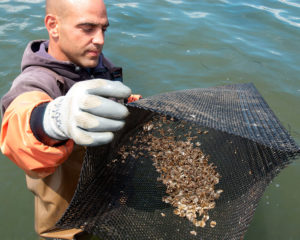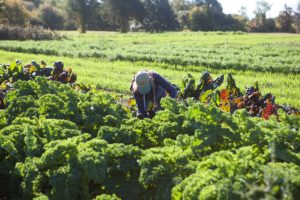
Perry protects his oysters with FSA’s Noninsured Crop Disaster Assistance Program.
By Leila Naylor, Rhode Island Farm Service Agency
Perry Raso is the owner of Matunuck Oyster Bar in South Kingstown, Rhode Island, where he serves oysters and vegetables fresh from his farm. This farm-to-table restaurant shucks thousands of oysters year-round and serves over 600 meals a day.
Working on the Water
Perry established his oyster farm in 2002 when he decided to lease acres on Potter Pond, a saltwater pond in South Kingstown. He began selling his oysters at a local restaurant and later branched out to selling at farmers markets and eventually wholesale.
Perry’s oyster farm now spans seven acres on Potter Pond, the oysters arranged in rows underwater. The farm gets seed oysters, about one millimeter in size, from a hatchery in Maine. These tiny oysters go into a nursery system where they grow in a carefully maintained, safe environment until they are big enough to grow out in Potter Pond.
The oysters are then sorted into bags by size, which are attached with bungee cords to PVC pipes laid out on the bottom of the pond. They stay there, filtering water while crystalizing calcium carbonate to increase their shell size. It takes these oysters two years on average to reach marketable size. Perry estimates he has around 20 million oysters on the farm.
To protect his operation, Perry enrolls his oysters in the Noninsured Crop Disaster Assistance Program, a safety-net program offered by USDA’s Farm Service Agency. NAP provides financial assistance to producers of noninsurable crops when low yields, loss of inventory, or prevented planting occur due to natural disasters.
Growing a Business
Perry opened Matunuck Oyster Bar in 2009. Looking to expand his business even more, Perry began growing organic vegetables to supplement his restaurant menu in 2012.
The farm currently grows organic herbs – such as rosemary and sage – along with salad greens, arugula, spinach, microgreens and Asian greens, carrots, kale, peas, beets, tomatoes, peppers, fennel, broccoli, cucumbers, and more.

Perry began growing organic vegetables to supplement his restaurant menu in 2012.
The Environmental Quality Incentives Program from USDA’s Natural Resources Conservation Service helped Perry acquire a high tunnel to extend his growing season. The program also helps Perry manage storm water runoff with several types of water control structures, helping protect the water quality in Potter Pond.
EQIP provides agricultural producers with financial resources and one-on-one help to plan and implement conservation practices that can lead to cleaner water and air, healthier soils, and better wildlife habitat, all while improving agricultural operations.
“As aquaculturists, it’s our job to grow food and we rely on the environment to do so,” said Perry. “Therefore, we must be stewards of the environment in order to sustain and grow our business.”
More Information
USDA offers a variety of risk management, disaster assistance, loan, and conservation programs to help agricultural producers in the United States weather ups and downs in the market and recover from natural disasters as well as invest in improvements to their operations. Learn about additional programs.
For more information about USDA programs and services, contact your local USDA service center.
JOIN THE CONVERSATION
For the digital version of this blog, visit #FridaysOnTheFarm
Follow the #FridaysOnTheFarm story series and other news you can use on farmers.gov and our social media channels: Twitter, Instagram, YouTube, Flickr, and Facebook.





